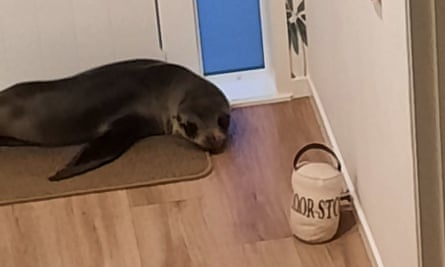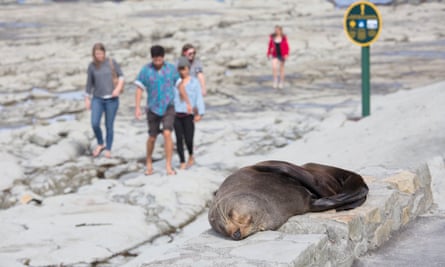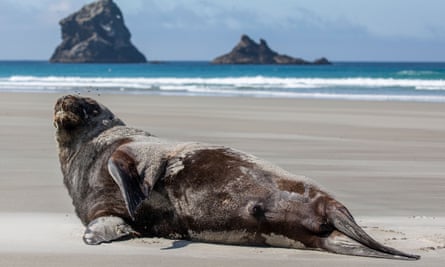Sunbathing on roads, breaking through catflaps, visiting film sets, invading homes and taking in the heat of backyard spa bath covers – New Zealand’s “seal silly season” has officially begun and the country is bracing for an influx of adolescent marine mammals exploring the country’s highways, patios and golf courses.
This week, the government issued a formal public notice that “seal season” had begun – and New Zealanders could expect to encounter higher numbers of the flippered young creatures out and about, exploring human-dominated spaces. From May until December, adult males and freshly weaned pups from New Zealand’s growing fur seal population will leave their breeding colonies and head out into the wider world – many for the first time. They’re young, inexperienced and prone to adolescent misbehaviour and mishaps, hitting the wider world en masse like a cohort of fresh-minted spring breakers.
“I call it seal silly season,” says Prof Louise Chilvers, an ecologist specialising in marine wildlife at Massey University. “It’s like having a teenager being kicked out of the home – they don’t quite know what to do, don’t quite know where to feed, don’t quite know what to do with themselves. They’ve got all this freedom, so they go do a bit of exploring,” she says. “Especially in the middle of winter, it’s cold, and there’s lots of nice warm places – like right in the middle of a tar seal road where it’s held all its heat from the day.”
Last year, one young seal broke into a home via the catflap, hung out on the couch and spent several hours traumatising the family cat before being escorted back to the sea. In 2021, a seal nicknamed “Sammy” spent more than a week occupying Hobbiton, the film set used on Peter Jackson’s The Lord of the Rings series, sunbathing and throwing eels around the lake. State highways are semi-regularly blocked by seals that have chosen them as a relaxation spot: last year, a reclining seal blocked State Highway 1, and the year before a pup stopped traffic on State Highway 25 as parents ferried their children to school.

The Department of Conservation warned the public that the pups were “exploratory by nature and exhibit some strange behaviours when hauled-up on land”, but should be left alone unless they were in immediate danger. People “may feel concerned seeing young pups alone, or seals regurgitating, sneezing, coughing or crying”, they said.
Laura Boren, a marine science adviser for the department, says that despite the season hitting every year, the department typically receives a flood of calls about the sea creatures turning up in odd spots. While many will stick to the beaches, some pups are more intrepid, ending up more than 90km from the shore.
“It’s a good conservation story that they are coming back,” Boren says, with the species recovering substantially since its numbers were decimated by sealing ships between the 1790s and 1940s. As the population returns, “they’ve been recolonising from the south to the north, and they’ve been starting to recover much of their former range”, she says. “But essentially, what we’re seeing now … is that they’re now coming into areas where we have a lot more human population.”

New Zealand’s sea lions are far rarer than seals, but as the species recovers, they too are increasingly exploring new places: occupying golf courses, conducting pitch invasions at football matches, and in one case, shutting down a busy section of road for several weeks after a sea lion mother chose it as a nursery spot.
As the spring breeding season approaches, marine mammals can also become confused, and seek love in the wrong places. In 2021, a flat of students blowing a conch shell attracted the affections of an amorous, 350kg male sea lion that demolished some of their garden and spent part of the day roaring through the windows after mistaking the noise for a prospective mate.

Both seals and sea lions are legally protected in New Zealand and conservation officers typically take a hands-off approach when they’re exploring, disturbing them only if they are in immediate danger and otherwise asking that people steer clear, slow down on open roads, keep their dogs on a leash, and enjoy their company from 20 metres away.

